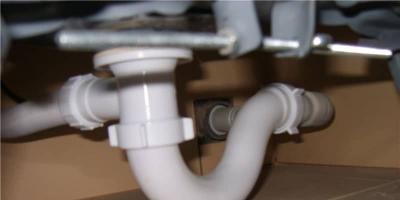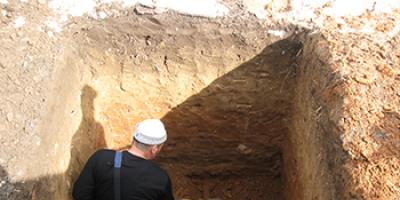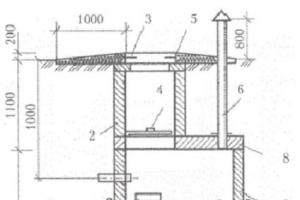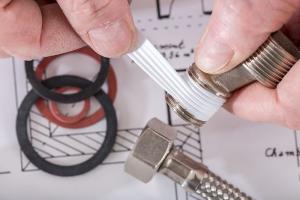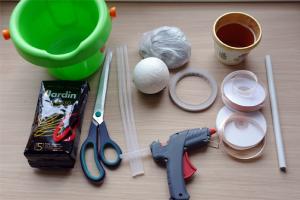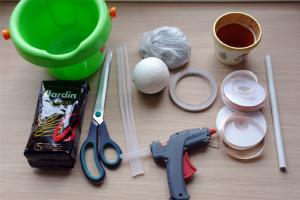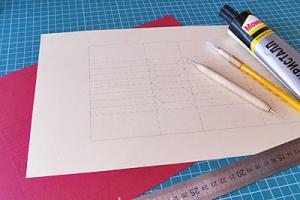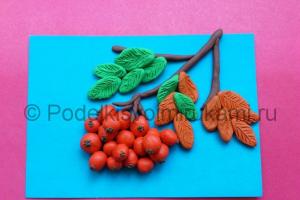Sometimes there is a need to quickly and easily make a high-quality cast of something. There is neither the money nor the desire to buy special and sometimes very expensive materials, and that’s when ingenuity and minimal knowledge of chemistry come to our aid. We will tell you how to prepare a mixture using available materials to take a high-quality impression with a good degree of detail.
Impression material:
To begin with, you should clearly understand that impressions and, accordingly, impression masses come in a variety of forms. For example, there are special impression compounds for taking impressions from the human body - they are harmless (almost harmless), and there are impression compounds for taking impressions of keys, etc. Try to use them for their intended purpose, the described recipe is suitable for inanimate, relatively solid objects , keychains, coins, medallions...
In order to make a mass for an impression you will need only two ingredients: ordinary silicone sealant(I used clear silicone sealant for sewer pipes) and potato starch.
 Figure No. 1 – Starch and sealant
Figure No. 1 – Starch and sealant You need to mix starch and sealant one to one in a deep, convenient container (a disposable plastic cup will do). You simply pour starch into a container (you determine the amount yourself, depending on your needs) and squeeze the silicone into it. Now take a spoon and start stirring it all continuously. I warn you! The mass must be mixed very thoroughly. At first the mixture is very sticky and viscous, but after twenty minutes it becomes empty and becomes like dough (plasticine), while the silicone no longer sticks to your hands or anything.
 Figure No. 2 – The mass no longer sticks to your hands
Figure No. 2 – The mass no longer sticks to your hands Now all you have to do is apply your mixture to what you want to make an impression of, and wait until it hardens. The advantage of this method is that there is no need to use a release agent since starch prevents the silicone from sticking. And the mixture quickly hardens, turning (I put it on the radiator and it was ready within an hour) into a reusable rubber mold with which you can easily make plaster casts and other products.
Available to everyone. A casting made according to all the rules and in compliance with the proportions when mixing the working solution will turn out to be very realistic.
The quality of the gypsum will depend appearance finished product and its strength characteristics. To achieve maximum similarity, a high-quality form is necessary. Special materials are used for its manufacture.
Idea
For lovers, a plaster cast of a pair of hands clasped together can serve as a gift for a significant date. Often this composition is ordered by newlyweds on their wedding day.
Parents order casts of children's hands and feet as souvenirs in addition to photographs and videos of their children. Such a souvenir, decorated in an elegant frame, can be presented to family and friends as a memory of a memorable date: a first or anniversary birthday, baptism, a child’s first independent step, etc.
You can create a whole collection of such casts made in different periods active growth child. Later, holding them in their palms, children may remember the happy moments of their childhood.
An elegant plaster hand, made and decorated with your own hands, can also serve as a detail of an original composition. This decoration, for example, can also be used as a mannequin for storing rings.
Gypsum
For mold castings there are many various materials. These are paraffin, wax, concrete, silicone, metals, even chocolate can be poured into food form. Nowadays plastic compositions and resins have become available. They all have their specific features casting To answer the question of how to do plaster arm, first you need to understand what kind of material it is. It is also important to understand the technology of its casting.
Gypsum powder is natural material. It is white or grayish in color, finely ground, and quickly absorbs moisture when water is added. It is obtained by firing gypsum stone and is distinguished by purpose: for medical purposes, for molding, for plastering works and plate production.

Gypsum for construction has a coarser grind, medical gypsum is the purest, molding gypsum sets more slowly. Useful property for sculptures is an increase (up to 1%) of the working staff in volume. This extension makes it possible to fill in a small drawing of a form. When preparing the solution, within a few minutes it begins to harden and completely sets within 20 minutes.
Features of the technology
Gypsum powder should be stored in a dry place. Wetted or damp material is unsuitable for casting; it does not set. Its characteristics also deteriorate from long-term storage. The gypsum working solution is prepared quickly. Due to prolonged stirring, it “rejuvenates” and sets weaker, which ultimately leads to a loss of strength of the finished product.
If the working solution has hardened before pouring is complete, it is no longer suitable for use. Adding water and stirring it again will not correct the situation. Liquid glue can help slow down the setting of the solution. It (3-4 spoons per bucket of water) is added first and mixed well.
The casting must be dried at temperatures up to 60 degrees. It is not advisable to exceed this limit - the material loses strength and begins to decompose. A do-it-yourself plaster hand is made taking into account all these nuances. To do ready product stronger, the solution is mixed with lime milk.
Moisture and dampness have a negative effect on gypsum products, so they must be used and stored indoors, especially if they do not have a protective coating.

Preparatory operations
Making a plaster hand on your own is possible at home without the use of any special technologies or special equipment. However, in order for the casting process to go smoothly, you need to carefully prepare. Different batches of gypsum (especially building gypsum) may have different setting times.
To find out exactly, it is best to carry out a test batch and pour a small amount of solution into any simple form. This will allow you to accurately calculate the proportions of gypsum and water and determine the time period within which the solution retains casting properties. Ultimately, this will help save material, time and nerves.
At the preparation stage, they determine the container for the mold, and also select a suitable vessel for mixing the gypsum solution. For one-time filling you can take disposable tableware. If you plan to continue casting, it is best to purchase rubber plaster for mixing the working solution.
Half of an old children's ball is suitable for these purposes. Dried plaster from the walls is easily peeled off when the rubber is deformed. The skin of the hand that will be immersed in the molding mass can be lubricated with a thin layer of castor oil or Vaseline.
Simple clay mold
A trial plaster cast of the hand can be successfully cast into a clay mold. This will not be a full-fledged volumetric copy, but it will provide an opportunity to get the first practical experience. Clay is available material, it can be used repeatedly after unsuccessful attempts, which is just right for beginners.
You need two pieces of board or plywood, 5 cm larger than your palm. Lubricate them and your hand vegetable oil or Vaseline. This is necessary so that the clay does not stick. Place your hand on the board, press it tightly and begin to apply clay moistened with water and kneaded to a thick dough, pressing it well and compacting it.

The total layer should be at least 5 cm. Its top is leveled flat and covered with another board. The entire structure, together with the hand, is carefully turned over. The bottom board is removed and the palm is carefully released. The form for filling is ready. To obtain ideal castings, plastic molding compounds are used.
Alginate for impressions
To make a mold for volumetric casting of complex shapes, special compositions are used. One of the most available options is an alginate mass. Its main purpose is to make impressions in dental practice. But such material is quite suitable for sculptural castings.
Alginate is a raw material from seaweed. Its dry powder, mixed with water in precise proportions, quickly thickens and acquires the properties of a dense jelly. If you place your hand in such a mass before the setting process begins, and then, after achieving optimal density, carefully remove it, a cavity will form in the mold. If you pour a gypsum solution into it, after hardening it forms an exact copy of the hand.
It will not be possible to remove the casting without destroying the mold. The alginate mass is not in a state of plasticity for long; it begins to lose moisture, becomes brittle and collapses from deformation. Therefore, filling with the working composition should be done immediately after removing the hand. In this case, you can expect a high quality cast copy.
Some brands of alginate masses change color as they harden. When kneading, they have one shade, in the initial setting phase (the optimal moment of immersion of the hand) - another, after reaching density (when the limb can be removed) - a third. The process of making a plaster hand using such a molding material is within the capabilities of anyone.

Preparation of the solution
A plaster hand is cast with your own hands in a pre-prepared mold. Fill the mixing container with clean, cold water. required quantity. Dry gypsum powder is evenly poured into it. Ideally, it should form a slide above the surface.
The gypsum begins to intensively absorb water. At this time it needs to be stirred well. This should not be done too intensely, as air bubbles will form. They remain in the solution, fall into the mold and, after it hardens, form shells and cavities. Therefore, you can use a drill with a kneading attachment only at low speeds. It's best to do everything by hand using a spoon or wooden stirrer. The goal is to obtain a homogeneous mass without lumps, reminiscent of sour cream in thickness.
The water/gypsum proportions (approximately one to two) are determined experimentally in advance. After mixing is completed, tap the container lightly to release air bubbles to the surface. The resulting foam is collected with a spoon. The prepared working solution is immediately poured into the mold. The time from the start of mixing to pouring is no more than a minute and a half.
Pouring into the mold
A do-it-yourself plaster hand is made by casting into a prepared mold. The solution is added in portions. If you fill a complex form with it all at once, air pockets may form in it. The gypsum solution does not get into such voids; as a result, the finished model will have defects.

To avoid this, the mold is turned in all directions after pouring in the first small part of the working solution. So it spreads over inner surface and gets into all the recesses. The air inside does not accumulate and is gradually displaced.
With the next portion, the gypsum solution is deposited on the walls more and more, its layer becomes thicker. Once the complex undercuts are completely filled, the remaining plaster can be poured.
The technology for making a cast of a child's hand is slightly different from the work process with adults. The fact is that a child, as a rule, cannot keep his hand in a constant position until the molding mass grabs. Moving your fingers while molding ruins everything. Therefore, it is best to carry out this procedure during sleep in its deep phase.
Alginate molding compound is used. It is kneaded in a suitable sized bowl. All components are prepared in advance according to the instructions. Pour alginate powder into the water and stir it with a spoon until smooth for about one minute.
For adults, cold water is used. But to prevent the child from waking up from contact with the cool mass during sleep, it is better to warm it up. Warm water for mixing significantly reduces the time it takes to use the molding compound, so everything needs to be done quickly.
When the mixture is ready, it is poured into a suitable glass, selected according to the child’s hand, and his limb is placed there. The hardening time of the mass is 1-2 minutes. During this period, you need to keep the form at rest in order to get a high-quality print.
After the allotted time, the baby's hand is carefully removed. As a rule, this happens without problems, since the shape is plastic and does not deform under light load.
Immediately after this, the working solution is prepared and poured. Keep the plaster in the mold for no more than 30 minutes. Later, the alginate mass begins to release water, which will negatively affect the casting. The mold is removed from the glass, cut into pieces, and the child's plaster handprint is released. It is cleaned and left to dry.
The same principle is used to cast the hand of an adult or child, who can hold the hand at rest during molding.

Kits for making 2D and 3D impressions yourself
IN Lately The copied souvenir plaster hand is popular among ordinary people. How to make it yourself is described in detail in the instructions for ready-made modeling kits. This kit is ideal for those who want to try their hand at volumetric casting, but are unable or unwilling to understand the brands of molding compounds and plaster.
The kit will cost more than separately purchased components. But manufacturers focus on the convenience of this configuration. In addition, they provide a quality guarantee on their materials. The set includes a dry hypoallergenic mass for molds; it is easy to prepare by adding water in the required ratio. High-strength model purified gypsum is also available.
The kit for making casts of simple impressions of hands or feet includes a plastic molding compound reusable. Before use, it is kneaded, an impression is made and plaster is poured into it. After solidification, the casting is removed. If re-filling is not expected, the mold is kneaded again until soft and stored in a plastic bag.
Finishing
How to make a plaster cast of a hand into a finished composition? To do this, it needs to be painted. For someone ideal option It will be tinted with gold or bronze paint. Another will choose a flesh tone or White color.
For decorative covering Acrylic emulsion will do, but a layer of it, although thin, can smooth out fine lines and folds in the cast. Although, if the copy turned out to be imperfect, then this option is quite suitable. If you need to preserve the smallest details, it is better to use spray paint.
Before finishing, the cast is inspected, all irregularities are polished, and defects are corrected. In order for the paint to lay down in an even layer, the workpiece can be pre-primed, allowed to dry and then sanded again with fine sandpaper.
For installation, select a decorative base at your discretion and mount a copy of the hand or a composition with it on glue. After drying, the souvenir can be varnished for greater effect.

How to make a plaster hand yourself to make copies?
Having mastered the technology of casting and making molds, you can try to expand the range of products. A copied plaster hand, made with your own hands, can serve as a detail of the original composition.
For example, if cast in the position of holding an object, it can serve as a phone stand. In another case it could be the base of a candlestick or table lamp. You can install a decorative glass in a plaster hand and this composition will turn into a holder for pens or original vase for flowers.
For mass copying, it is not practical to produce disposable forms. In this case would be better suited elastic silicone. Molds made from this material can be reused many times. To remove the casting, they are cut on one side and the copy is carefully removed.
The silicone is installed in the container in which it was poured during manufacture, and the process is repeated. To make it easier to remove castings, release agents can be used. In such molds you can pour not only plaster, but also paraffin, tin or chocolate. The authors' imagination is limitless - the main thing is not to be afraid to experiment!
The memory of unforgettable moments of childhood can be left not only by photography, but also model gel for impressions, used to create precise outlines of your baby's legs or arms.
Today they are purchased not only by parents, but also by godparents and grandparents who want the imprint of unique little children’s hands to remain not only on paper.
Using the gel, you can create an impression that conveys the smallest details child's hands.
Modeling gel is also used to create an exact shape that conveys lines, curves and other smallest subtleties of the body.
You can order the work of a master making impressions. Some of them also work in creating paintings with casts - this is a wonderful creation that will be interesting to you and your child when he grows up.
If necessary, you can purchase a gel for taking impressions yourself and perform the entire procedure yourself.
Instructions for use are usually included with the package. The most common modeling gel is offered by many companies, including Hands and Legs and Socrates.
To create a 3D cast, you no longer need to look for a sculptor or other craftsman in this field, since you can purchase a special modeling gel designed for a certain age of the child and create a unique painting or sculpture reminiscent of the child’s childhood.
Creating a cast will take no more than half an hour if you carefully follow the instructions in the instructions.
Some sets also include postcards on which you can later place the created cast. Or you can buy a frame in advance in which the child’s photograph will be placed.
The step-by-step process for making impressions is completely simple and understandable:
- Initially, you need to immerse the arm or leg in modeling gel, which hardens quickly. Creating the form in this case will take about 2 minutes. Moreover, you don’t have to worry that the consistency can cause allergies, since it is completely safe even for the little ones. The unique gel not only preserves the original size of the palm, but also repeats all the subtleties of lines, nails, and folds.
- After this, high-precision plaster for modeling needs to be poured into the resulting mold.
- After about two hours, the sculpture must be freed from the model material and thus obtain an absolutely exact copy of a small arm or leg. If desired, such a sculpture can be decorated in any way: coated with varnish or other coating, made with an inscription, decorated with some decorative elements.
Recently, many loving couples have become interested in this gel, which can immerse their clasped hands together and capture the tenderness of feelings for many years.
Everyone, even not an avid romantic, will probably be happy with such a surprise.
You can purchase 3D gel for impressions in a wide range in many chain stores or on Internet portals. A set consisting of gel and plaster must be certified, like any other product.
The presence of instructions is also important, although they may not be offered - they only sell sachets of gel, which have a lower cost compared to the full set.
When purchasing model gel, do not forget to provide the amount of material, which the site’s consultants can also help you calculate.
Naturally, it is advisable to buy 3D gel for impressions from companies that inspire trust, especially if you want to make an impression of a child’s hand, since everyone can guarantee the safety of the composition, but what it actually is is not known.
Don't miss the opportunity to get a unique family heirloom, the unusualness of which will attract and constantly remind you of a certain moment in life. In addition, the cost of model gel for impressions is reasonable, so anyone can purchase it.
Currently, many parents make casts of children's hands and feet with their own hands. Such a memorable print looks very cute and will allow you to remember the wonderful moments of early childhood for many years.
DIY casts of children's hands and feet
- Step 1: Mix mold powder with water. The result is a paste, which must be transferred to a container where the impression will be made. You need to place an arm or leg into the mass. The paste will begin to harden and turn white. Then, you should wait for approximately one minute for the mixture to completely harden if the water is used at room temperature;
- Step 2. Move your arm or leg to make it slide out of the mold;
- Step 3. Mix the plaster with water, making sure there are no lumps. Pour the mixture into the mold. Leave the imprint for a while so that the plaster hardens;
- Step 4: Tear or cut off pieces of the mold to release the cast;
- Step 5. After drying, paint the cast in the chosen color or varnish. If you purchased a set with a frame or stand, glue it in place.
To make casts of arms and legs with your own hands, you don’t need experience, you just need to carefully read the instructions. As a rule, sets contain everything necessary materials and tools. In addition, they often provide the opportunity to make several casts, because working with a child is completely unpredictable, and whether the perfect contour will turn out depends largely on our small models.
How to prepare for making a three-dimensional cast of arms and legs with your own hands:
- take care of the little model’s good mood;
- you can use sleep time;
- Residue from the mixture after making may be difficult to wash off, so wear clothes that you don’t mind getting dirty;
- the participation of two adults is necessary - one to take care of mixing the ingredients, the second to hold the baby and distract him;
- if you have touched the sides or bottom of the mold, you can pour plaster into it and then smooth out any imperfections with sandpaper;
- the time it takes for the mold to completely harden depends on the temperature of the water used - than colder water, the longer it will harden, the warmer the water, the faster the material will harden, room temperature water is optimal;
- Make sure the containers are the right size for your baby's feet or hands.
How to prepare a child to make a cast of children's hands and feet with your own hands

Take advantage of the moment when little models are calm, this could be a moment of sleep or watching a cartoon. Some sleepyheads can sleep through all the fun and don't even notice what's happening around them.
However, if the child is sensitive to cold, it is important to wet the hands or feet with water first so that the baby has a chance to get used to the temperature of the mass.
If this doesn't help you can add warm water, but keep in mind that the higher the temperature, the faster the mass will harden.
In this case, you can add a little more water than indicated in the instructions or add not all the contents of the bag.
If you want to make a mold for casting while the child is awake, you must find a moment when the baby is in a good mood, calm, well-fed and well-rested. Provide an attractive toy, book, or other entertainment to distract your baby.
Don't worry if your little one moves his fingers a little, this will have a positive effect on the final result, allowing air bubbles to escape while allowing the mixture to get into the gaps between the fingers. If your child moves his hand, try gently moving the container behind his hand. Of course, you can hold the handle gently, but remember to remain calm and not forcefully hold your baby. Otherwise, the baby will receive unnecessary stress, and the quality of the impression will be reduced. The mass hardens quickly, so just wait a little and everything will be ready.
Some children do not like it when their leg or arm is immobilized, then you can add less water, which will speed up the hardening time. If the child reacts poorly to the moment the arm or leg is immersed in the mass, it is recommended to wait a while. for example, 2 weeks, and try again.
How to prepare molds for casting casts for children with your own hands
To make an impression with your own hands, mix the mold powder with water in any container and pour it into a closed plastic container; you can mix the mixture directly in the same container. Measure ingredients accurately as poor ratios can affect the final result. You can use a test sample, which is sometimes included with the kit, to have information about the curing process.
Wet the skin of children's feet or hands thoroughly so that they slide out of the hardened mold easily.

Thanks to this manipulation, your child will be able to get used to the temperature of the mass, in addition, we will minimize the risk of air bubbles that worsen the quality of the product. Guide your baby's hand so that it slides accurately and accurately into the prepared paste.
Don't worry if your baby moves his arm. The beginning of the hardening process will show a change in the color of the paste, and this is the moment at which the child should not make very sudden movements. After hardening (about 1-1.5 minutes), remove the handle. To avoid holes in the set mold, guide your child's hand without touching the bottom or sides of the container.
How to prepare and pour plaster
Pouring plaster should not last longer than 5-6 minutes.
- Prepare a plastic bowl, measure out the required amount of water and plaster in the appropriate proportions. Always add powder to water, not the other way around;
- Pour the plaster of Paris into the water slowly, stirring constantly, until the mixture reaches the consistency of very thin yogurt. Mixing too intensively and for a long time can lead to the mass beginning to harden already during pouring into the mold. Also, stirring too much can cause bubbles to form. If you see bubbles on the surface, tap the container a few times to release them;
- Initially the plaster is very watery, but after a while it gently begins to thicken. The plaster is ready when it reaches the consistency of pancake batter. Then, pour a small amount of plaster into the mold and carefully move the container in different directions so that the mass fills exactly every hole;
- After filling the form 1/3, tap the container on the table surface;
- Pour in the rest of the mixture in batches;
- Leave the container to harden for several hours.
How to avoid air bubbles in plaster?
Air bubbles spoil volumetric impressions; as a result, the plaster does not reach the fingertips, and the impression will not completely replicate the child’s hand. This problem mainly occurs with hand impressions, since the fingers on them are longer than on the feet, and the plaster does not always flow well into these holes.
You can use the following methods to avoid this:

- do not mix the gypsum mixture for too long;
- vigorously and repeatedly tap the container with plaster on the table;
- puncture large bubbles that appear on the surface;
- first pour a small amount of plaster and move it in different directions so that it spreads evenly throughout the entire form;
- pour the mixture down the sides, holding the container with the mold at an angle - if the mold is in a vertical position and you pour from above, there is a risk that the mixture will not fill the holes to your fingertips;
- in the case of legs, if you fill half the mold, you can take a brush and use it to spread the mass;
- For handles, you should tilt the mold with your fingers down so that the mass flows there.
In what position is it most convenient to make 3D impressions?
0-5 months. For very young children, the procedure should be carried out in a supine position, as for feeding.
The most beautiful phenomenon created by nature is the birth of a child.
In the modern world, with the help various types equipment (camera, video camera) you can track the baby’s development from the very first day of life.
But many people want to look at their baby not only from photographs and videos. Therefore, they often order from studios so-called copies of the child’s arms and legs - casts, which can be made from almost any hardening material - plaster, chocolate, wax, liquid glass and other materials.
But in this article we will focus on other types of impressions - the so-called 3D impressions. In another way they are also called volumetric.
On the Internet you can find the technology for their manufacture, but rarely do you see information about them. component composition. In this publication we will reveal this secret to you.
So, to make a three-dimensional cast of a child’s hand or foot, we will need:
- gypsum (or other hardening material)
- alginate (sold in dental stores)
- water (36.6 degrees)
Before you start work, you need to put your baby to sleep in a crib or cradle (if the toddler is still small). This is necessary so that he does not move his arm or leg while taking the impression.
Then we prepare the impression mass. To do this, select the required amount of alginate powder and water in accordance with 1.5 to 1.
Pour the alginate into the water (not the other way around!) and stir with a mixer or spoon. You just need to do this very quickly, as it hardens almost immediately.
Then we immerse the baby’s hand (leg) in this mass and wait for it to harden. You can check whether it has frozen or not with your finger - touch the surface of the mass - if it does not stick to your hands, then the solidification has ended. As a result, it should feel like rubber.
Now, very carefully, so as not to damage the impression mass, we remove the child’s limb from it and put it back to sleep under the supervision of a baby monitor or video baby monitor. We will get a kind of deepening.
The next step is to prepare a solution of gypsum and water. Pour the plaster into the water (and not the other way around!) and stir it until it reaches the consistency of thick sour cream and fill the resulting cast with this solution. We wait a day. Then carefully use a knife to cut the alginate along the edges of the container, turn it over and make an incision in the mass to pull out the resulting cast.
That's all. As they say, everything ingenious is simple. Now your baby’s three-dimensional cast will be preserved for life and will constantly remind you of the moments of his childhood.
The Chameleon company invites you to try yourself in an interesting business: Making compositions with casts of baby’s arms and legs, 3D copies of newlyweds’ hands, commemorative medals with handprints, casts of pets’ paws.
What it looks like:

Formats
You can run this business at home or open a location in a large shopping center, offering a wider range of services.
"Home" format
If you work from home, orders are accepted as follows. The client calls on the phone. The time and date of the specialist’s arrival at your home are discussed. At the appointed time, the necessary impressions are taken at the client’s home, photographs of the baby are taken, and design options are discussed. All conditions are written down on the order form. It also reflects the amount of the advance payment for the composition and issues a sales receipt. The master takes away the casts and carries out all the rest of the work on filling and further design of the composition at home.
The finished work is delivered to the client’s home or he picks it up himself at the place specified by the master, and, if necessary, pays the remaining amount.
Studio format
If you work in a studio or have retail space in a shopping center, orders are accepted on site by the manager or by phone. Impressions can be taken both in the studio and at the customer’s home, at his discretion. The advantage of going to the client’s home is that such conditions are more comfortable for the baby, with familiar toys and surroundings nearby.
As you can see, the business is quite simple, it does not require special knowledge, significant investments, you only need desire, and in everything else we will help you, from technology to consultations on business management.
The target audience
Potential buyers are: loving parents, grandparents, godparents. Families with average and above average income. The age of the main client is from 23-45 years.
Promotion methods
The target audience is informed about this service by placing advertisements in: maternity hospitals, kindergartens (nurseries), photo salons and photo studios, children's goods stores, registry offices. The main thing in this business is to make yourself known at the beginning of work by advertising in the above-mentioned places and placing ready-made sample compositions in places where potential clients gather. In the future, word of mouth has a good effect.
Key Features
The main features and advantages are:
- lack of license and special permits
- minimum investment
- high profitability
- quick payback
- opportunity to show your creativity
- Great part-time job for moms on maternity leave
- It is not necessary to have an office; you can work from home
- There is practically no seasonality
Technology
The technology for making impressions of handles is quite simple.
- A very plastic, soft, reusable material is used, which allows even the smallest children to take impressions from birth.
- The process of taking an impression takes several minutes. After which the master takes away the casts and fills them with gypsum solution at the workplace; after the gypsum has hardened, the product is processed, if there are defects, and left to dry further.
- While the impressions are drying, you can process the photo in the program.
- Next, the composition is assembled - all the elements are glued to the base and inserted into the frame.
The time required for the production of one fully designed composition is: 1 day, of which 12 hours for drying the casts (this process can be accelerated by drying the casts in the oven), immediately going to the client, processing the photo and printing it.

What equipment is required to start this business?
Basic equipment
No special equipment is required, and what is listed is already in almost every home.
A printer is not necessary in this case, because
Printing large format photographs for compositions is in any case carried out in a photo studio.
The work requires plastic containers in the form of disposable plates for taking impressions, 1.5-3 liter containers for 3D copies of hands, a mixer or a spoon for kneading.
How much money do you need to start?
- Capital equipment: 25,000
- Accessories: no
- Purchase of raw materials and Supplies 1,500 rub.
- Purchasing a business package - from RUB 5,300.
- Costs for an advertising campaign - from 3,000 rubles.
- Total: 34,800 rub.
How much can you earn from this?
The cost of making one impression using reusable material is 10 rubles, including plaster and paint.
Frame frame with glass (framing workshop) - 500 rub.
We create casts of arms and legs ourselves using alginate gel and plaster
and higher, depending on the baguette option
Composition design:
- photo collage and decorative elements— 100 rub.
- decoration for a frame without glass - 100-200 rubles.
The total cost of the composition is 600-700 rubles.
Retail price
The price of a 30x40 format composition with two children's casts is 2,000-5,000 rubles.
As a result, the income from one composition is 1300 - 3500 rubles.
In practice, for a city with a population of 150 thousand people, the average number of orders per month is 20 pieces, i.e. net profit about 30 -35,000 rubles. (assuming you run your business from home). Return on investment: 1.5 -2 months
Offer from the Chameleon company
By purchasing a business package from us, you get at your disposal detailed guide to create your own impression business, in which we pass on all our experience and knowledge to you.
Depending on the type of business package, you receive a set of materials and a personal website for starting your new business.
Plus, you will be provided with free consulting support on all issues of running this business and without time limits.
Update December 2015
Another option for opening a studio for making casts of arms and legs is offered by the company "Present Day" (investments from 30,000 rubles). You can familiarize yourself with the terms of the franchise or leave a request below detailed information about the proposed business model.
Contact details
- Chameleon Company
- mob. 8 913 792 7363, 906 965 6423
- Skype: chameleon2108
- Email: [email protected]
Questions and answers on the topic
View all (1)
We make casts of children's hands and feet with our own hands!
Home — Articles — We make casts of children’s hands and feet with our own hands!
Hello dear readers, I’m finally ready for a new article!
It's been a year and a half since my last inspiration!
A lot of new things have happened in my life, the most important thing is that my son, Leonid, was born (in January 2014), my second child!
Now he is already 6.5 months old. And I started working with casts again!
How to make a cast of a hand and foot with your own hands from plaster? We answer: “Very simple!”
There are a lot of kits in stores for making them, and on the Internet there are a lot of different tips on how to do it!
In 2011, 3 years ago, when I was making casts of Danochka’s hand and legs, I first bought a ready-made set.
How to make a 3D cast of a child's hand and feet at home
I did everything according to the instructions. I mixed the mixture, put the sleeping child’s hand into the plate, and my Danulya took it and woke up and threw all this liquid over me! While I was washing myself, the second jar of gel dried out. Bottom line: I wasted my money!
Then I went to my favorite Internet and saw many recipes for making children’s casts from plaster.
I want to tell you the simplest and most easy way making casts of my favorite arms and legs, which I liked the most!
To make children's casts you will need: 
For the test:
- half a glass of water,
- two tablespoons of sunflower oil,
(butter is needed to make the dough more elastic)
- one glass of flour,
- one glass of salt
(preferably fine, salt is needed to make the dough “obedient” so that it holds its shape better)
The volume of my glass is 150 milliliters.
To make the casts themselves:
- plaster,
- water.
Where can I get plaster for making children's casts?
1. Can be bought at the construction market.
2. You can buy any children's creativity set, for example, the “Sculptor” set.
I still have this set from 2011 :)
First we make the dough.
Mix salt and flour in a plate, add oil and water, mix everything.
The dough should be dense! If the dough turns out liquid, add more flour.
Divide the dough in half and roll it out with your hands.
You need to get two small round but thick (2-3 cm) cakes so that the cast is more voluminous. 
We take the little one and make footprints and handprints!
Making a print of a child's foot 
Making a child's handprint 
The first time with Dana I made the right arm and left leg.
The second time with Leonid, I made the right arm and right leg.
It's better to do it like the first time, for example, left hand And right leg or vice versa.
I think it looks prettier this way!
Next we take disposable cup, pour water, add plaster and mix everything.
I don’t specifically write the proportions of water and plaster, since I made the liquid plaster “by eye.”
The consistency should be like sour cream or kefir.
We pour liquid plaster into our children's prints and wait. 
When the plaster has hardened, remove the dough and our casts are ready! 
The remaining dough can be easily removed with ordinary water.
Children's casts are ready! 
All that's left is to decorate them!
You can color the casts however you like, I used pink and silver nail polish!
First I painted the children's casts with pink and then with silver varnish.
This is what happened. 
Next, I found a beautiful frame on the Internet, added a photo of the child and signed the age - I printed the photo!
Bought regular photo frame, included a photo, a pregnancy test, a bracelet and a tag from the maternity hospital!
I glued the finished children's casts onto the glass with double-sided tape!
So a beautiful frame with children's casts is ready for a long memory! 
You can add baby's first clothes, pacifier and much more.
For comparison, I’m posting a photo of my first frame with casts! 
Now we have this beauty at home: 
Children's casts can be made at any age, but to make it easier to attach them, it is better when they are still tiny.
The sooner you make your impressions, the easier it is to attach them to the photo frame!
Happy creations!
P.S. : The only thing I still don’t understand is how to remove air bubbles from the plaster?
There are small dots on the casts.
Maybe you need to stir longer?!

